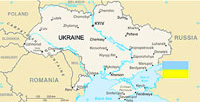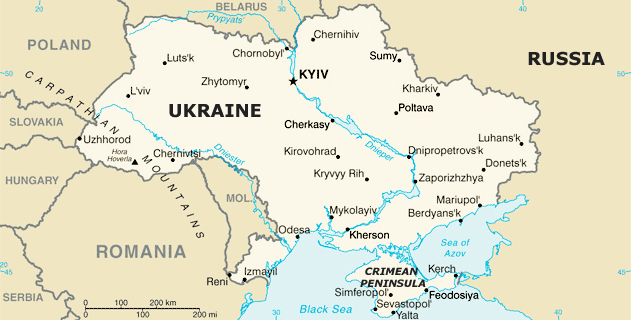Back-of-envelope estimate of cost to Russia of Ukraine crisis is $100 billion in 2014

(Business New Europe – bne.eu – Timothy Ash of Standard Bank – October 15, 2014) Russia’s foreign minister, Sergey Lavrov, this week estimated that the crisis in Ukraine would likely cost the German economy €40bn this year, and a further €50bn in 2015 – presumably through lost exports, and a broader disruption to the German economy and weaker resulting real GDP growth. It is unclear how Lavrov derived his figures, but these are not insignificant numbers being bandied about, ie. around 0.7% of GDP on an annual basis.
With this in mind, it is worthwhile perhaps to try and estimate the losses of the crisis to both Ukraine and Russia.
In Ukraine’s case, it is perhaps important to distinguish between losses resulting from the conflict and those relating to the underlying economic crisis that is resulting from the unsustainable policies run by the former Yanukovych regime – twin deficits were always going to end in a major macroeconomic adjustment, with a large exchange rate adjustment required and likely a corresponding recession as domestic demand “shrunk to fit.”
In a scenario where no conflict occurred, real GDP might have contracted by 2-3% year on year, and the exchange rate likely dropping from UAH8.2:USD1 to more like UAH9.5:USD1+. This would likely have cut dollar GDP from $178bn in 2013 to more like $157bn in 2014. It might reasonably be argued that the recession/devaluation might have been moderated by access to Russia’s $15bn bailout bond facility, and the provision of cheap Russian gas/energy – albeit as has proven the case in neighbouring Belarus, such Russian support tends to stall much needed longer term reform, and ensures that economic losses are sustained over a longer period of time.
As is, as a result of the onset of conflict, we estimate a real GDP contraction this year of 9-10%, we assume nominal hryvnia GDP flat-lining due to an acceleration in the GDP deflator from exchange rate pass through to inflation, and with the exchange rate depreciating to average around UAH11.5:USD1 for the year, which takes dollar GDP down to around $127bn, implying a loss of $30bn on the no-conflict scenario as noted above or the equivalent to around 17% of GDP for 2013.
We would note that this is likely the result of the loss of Crimea, parts of the eastern Donbass region, the actual conflict, plus also disruption to trade and energy ties to Russia. We would also note that the hryvnia has been relatively unmoved by the recent broader dollar rally, as the National Band of Ukraine (NBU) imposes administrative tools to try and hold the hryvnia around current levels of UAH12.9:USD1 – arguably the currency should be much weaker if left to its own devises, and indeed the black market rate for the currency is currently nearer to UAH15:USD1, which would imply even large dollar GDP losses as above.
The above represents a flow loss of GDP, but there is also a loss of assets (stock GDP in effect) – in terms of destruction to the stock of wealth/assets, including infrastructure. Therein official sources are suggesting that the costs of repairing roads, bridges, housing and infrastructure might total as much as $2bn.
In addition, the crisis has resulted in a deterioration of the public finances, a wider budget deficit (now over 10% of GDP) and increased borrowing costs. The original International Monetary Fund (IMF) programme agreed in March assumed the stock of public sector debts of $73bn as of the end of 2013, rising to $82bn by the end of 2014. This was revised up again during the first review under the Stand-By Arrangement (SBA) in July, and after the first onset of hostilities to $92bn, which might still prove to be an under-estimate. However, this suggests an additional $10bn in increased public sector borrowings as a result of the conflict – it might be argued that the IMF also simply underestimated the economic adjustments required as a result of the policy failures of the Yanukovych regime.
All told the above might suggest an “all-in” cost to Ukraine of the current conflict of around $42bn, including a $30bn loss in dollar GDP as a result of the conflict, $2bn infrastructure losses, and perhaps an additional $10bn in terms of increased public sector indebtedness. Clearly for a poor country, these losses are huge and impose a systemic burden, with the hope being that Western financial support can partly fill this gap.
100bn dollar question
Applying some similar analysis to Russia, I estimate that real GDP losses are in the 0.5-0.75% range – pre-Ukraine crisis, the market consensus was for real GDP growth of around 0.75%-1% for 2014 for Russia. At present, the consensus is for real GDP growth of zero to 0.2-3% for 2014.
Sanctions and concern generally has also weighed on the ruble – albeit lower oil prices and a general trend to a weaker rouble on longstanding concerns over Russia’s real GDP trajectory are also weighing there. We assume an average ruble rate for 2014 of RUB37:USD1, from RUB31.8:USD1 in 2013. We assume around one-third of the exchange rate weakening from 2013 to 2014 is Ukraine-conflict related, ie. we assume that the ruble would have weakened anyway to an average rate of around RUB35.26:USD1 due to weak underlying growth, dollar strength and lower oil prices.
We hike the GDP deflator for Russia for 2014 by 2 percentage points to account for the impact of the food import ban and some exchange rate pass to inflation. We assume 0.25% real GDP growth in 2014, as opposed to 0.75% in no conflict scenario. Overall, our results suggest that without the conflict Russia’s dollar GDP in 2014 would have dropped from $2,099 billion in 2013, to $2,022 billion. However, assuming a larger nominal exchange rate correction and weaker real GDP growth this takes dollar GDP down to $1,953bn, implying a loss of around $69bn, or just under 3.3% of GDP again. Note that the IMF using similar GDP/deflator assumption forecast dollar GDP for Russia dropping to $2,057bn in 2014, albeit they arguably use an optimistic exchange rate assumption now of RUB35.3:USD1 – already exceeded this year.
In Russia’s case it might also be appropriate to add in losses in foreign exchange reserves defending the ruble. Thus far in 2014, forex reserves have dropped $56.9bn, and on the current rate of depletion total reserve loss for the year might total $65bn. This compares with reserve loss of $25.8bn for the full year in 2013. Again it is reasonable to take out intervention that might have been driven by underlying ruble weakness related to oil prices and weak growth drivers. However, it does not appear unreasonable to assume that one half of reserve loss – maybe $30bn or so – might be specifically related to attempts to counter capital flight tied to the crisis in Ukraine and the imposition of Western sanctions on Russia, which has hurt overall sentiment.
All told, the above suggests an overall loss to Russia of perhaps as much as $100bn, or just under 5% of GDP, which is very large. This makes no assumptions in terms of military losses incurred, and higher fiscal costs associated with required investments/fiscal drag from Crimea, which could also reach into the tens of billions of dollar – particularly in terms of the construction of a new bridge to connect Russia with Crimea (preliminary estimates put the cost at RUB300bn, or $8bn).
Also, there appears to be ongoing costs for Russia’s support for separatists in the Donbass – currently 2.5% of Ukrainian territory occupied by pro-Russian forces. Arguably, many of these costs have yet to be assumed. As a very rough estimate, supporting Crimea and regions of Donbass controlled by separatists could easily drain $5bn (0.3% of Russian GDP) annual disbursement from the Russian budget – given the economies of these two regions have all but collapsed, and Russia will now be responsible for provision of social support for their populations, supply of energy and rebuilding costs.
Note that in terms of the dollar GDP losses as noted above, these are the losses only incurred for 2014, but the crisis in Ukraine and sanctions are likely to impose a longer term drag on both economies – ie. recurring and cumulatively growing losses. These may well be diminishing but none the less very significant.
Now clearly on the above we could have a discussion as to whether it is useful to include real depreciation/appreciation in measuring losses, and whether dollar GDP is the best means to do this, rather than simply real GDP losses. That said, countries often use dollar GDP, and dollar per-capita GDP, when it is rising as a measure of wealth/well-being, and indeed dollar GDP is used as a key measure of key ratios, such as current account/GDP, gross external debt/GDP, etc and on a relative basis. It is important therefore to the overall story.

